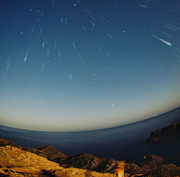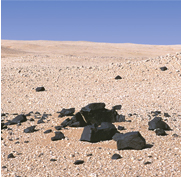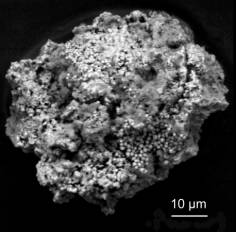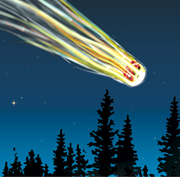Meteoroid, Meteor, Meteorite: Are You Cosmically Confused?

Enlargement
Photograph of a meteor shower taken from Spain during the Leonids of November 2002. |
A meteoroid is a solid object less than one kilometre in diameter that is in orbit around the Sun and that, under the right circumstances, could possibly hit the Earth. Most meteoroids are the size of a speck of dust or a grain of rice. As they pass through our planet’s atmosphere, they burn up, leaving a short-lived trail of light in the sky. This phenomenon is called a meteor or shooting star. If the meteoroid is bigger, instead of just a trail of light going across the sky, there is a ball of fire. This is called a fireball. A meteoroid fragment the size of a baseball can reach the Earth’s surface and become a meteorite. Does this mean that only very large bodies survive the trip through Earth’s atmosphere? No! If the meteoroid measures less than 0.001 millimetre, it lands gently without burning up: it is a micrometeorite.
 |
| Enlargement |
| Fragments of the meteorite Dar al Gani 749 that landed in Libya. |
 |
| Enlargement |
| This micrometeorite, 50 micrometres in diameter, was collected from snow in the Antarctic. |
Passage Through the Atmosphere: A Sound and Light Show

Enlargement
Representation of a glowing meteoroid passing through the atmosphere. This meteoroid will become a meteorite. |
When it enters the atmosphere, a meteoroid is suddenly slowed down. Friction from contact with the air heats the fragment. Its surface liquefies and vaporizes. The object and the air surrounding it glow: an impressive ball of fire crosses the sky, changing from bright white to red. When it has slowed down enough, the meteoroid quickly cools down, and it stops glowing. From this moment on, gravity alone is pulling it towards the ground.
The passage of a meteoroid makes different sounds that can shake windows and buildings. Travelling faster than the speed of sound causes a sonic boom that is heard a short time after the fireball has gone by. A meteorite that is discovered after it is seen falling is called a fall. Meteorites discovered by chance are called finds.
On April 25, 1969, a resident of Bovedy, Northern Ireland, was recording birds singing in her yard when a meteoroid entered the atmosphere. Explosions can be heard two thirds of the way through the recording, followed by the barking of a frightened dog.
|